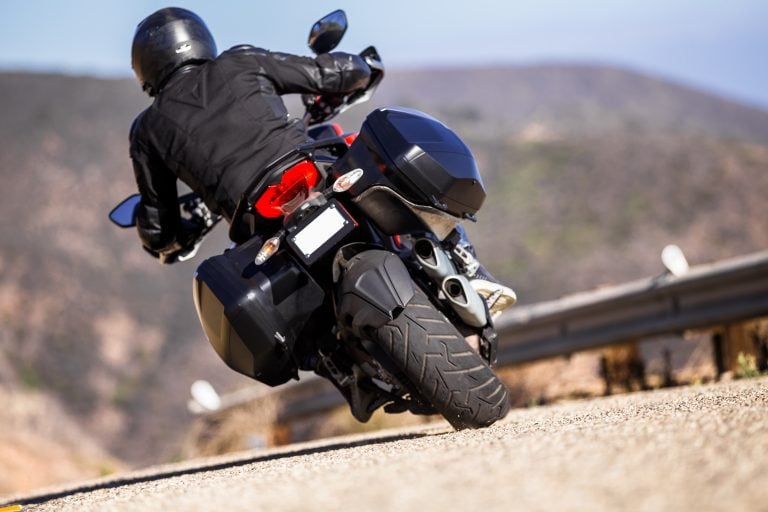Riding coach Misti Hurst explains the correct technique to use when emergency braking.
Emergency Braking
Emergency braking is an extremely important aspect of motorcycle riding and, with a little bit of rider education and training, can become a well-learned and well-executed skill. Some of the errors associated with improper emergency braking include locking up the rear tyre, locking up the front tyre, locking the front and then completely letting go of the brakes, target fixation, or grabbing the front brake so hard and for so long that the rear tyre lifts in the air or the bike flips. All of these errors are avoidable.
Let’s talk about how to avoid locking up the rear tyre first. It doesn’t take much pressure on the rear brake to get it to lock up. With a locked rear tyre, you lose valuable traction and the backend of your motorcycle has a tendency to fishtail, or skid violently to one side or the other. Less pressure on the rear brake initially will help to prevent this from happening and, if you do lock it up, just let off the pressure slightly until it is no longer locked. Don’t slam it on and don’t chop it off.
Locking the front tyre can be another result of improper emergency braking technique. It’s something that most people don’t experience until it happens in an emergency situation. A locked front tyre can skid and has a tendency to wobble back and forth, often resulting in a tuck of the front wheel, and a crash. Other outcomes are that the rider panics when they begin skidding, so they release the brakes and end up hitting the very thing they were trying to avoid.
The key to successful emergency braking and avoiding locking your tyres up is to apply the brakes quickly but smoothly, progressively and evenly, just to the point before initial lock up. If the tyres do lock or skid, then letting off the brake slightly while still maintaining good control will allow the wheel to unlock and the tyre to regain traction. Releasing completely and then re-applying takes too long. Instead, release the brake slightly while still continuing to slow the bike.
If the rear tyre begins to come off the ground while braking, it’s usually because the rider gave an extra hard squeeze at the end of braking, or that their bodyweight slid forward quickly. To prevent this, ensure the brakes are applied evenly, and stop your body from sliding forward into the tank by pinching your knees.
Gripping the tank with your legs also allows you to stay relaxed so that there is no extra pressure on the bars. If the rear tyre does come off the ground, release the front brake slightly until it returns and you continue to slow or stop. Adding rear brake will bring it down as well. Always remember to avoid target fixating while braking or you may end up hitting the thing you want to avoid simply by looking at it. By keeping your vision wide and seeing the available space around the problem, you can help avoid this.
If you are able to brake safely and come to a complete stop then do so, but if you think you can’t stop in time, then brake hard to scrub off some speed, release the brake completely and quickly steer around the problem. Don’t try to steer the bike with any amount of brake on. Emergency braking can be practiced in a carpark or empty side street slowly and consistently until you’re able to reduce your overall braking distance and you feel confident in doing it quickly and safely. Practice makes perfect and being prepared is key to mastering these techniques.
Trailbraking into turns
Plenty of people will tell you to do your braking and set your speed before you turn into a corner, which is good advice. However, there is a technique called trail braking which can get you out of a sticky situation if you misjudge the amount of speed you can carry into a tight corner or hairpin turn. Gradually releasing your brakes as you turn into the corner can help slow down your entry speed and stop you overshooting the turn. The main thing to remember when trailing the brakes is that, as you add more lean angle, you must decrease the amount of front brake being used.
As with most riding techniques, the key to good execution is being smooth with the controls. When braking, avoid snatching the front brake or squeezing with inconsistency. Avoid any kind of jerky or uneven pressure, or rough and overly aggressive movements on either of the brakes. The idea is to give smooth, even, consistent pressure on the brakes, both when pulling them on and releasing them, to reduce any excess instability of the motorcycle and to prevent locking up either of the wheels.
Two fingers on the front brake lever is usually sufficient. Keep your arms relaxed by squeezing the tank with your knees to ensure you don’t put extra weight on the handlebars. Excess weight on the bars can cause a front-end wobble or tank slapper.
If you must add brake while mid corner (as in an emergency situation) then you should do so smoothly and firmly while at the same time counter steering the bike back upright. Braking is much more effective if the bike is not leaned over.
Practicing these techniques can improve your overall riding and ensure that you are ready and prepared for any emergency braking situations. Ride safe.

